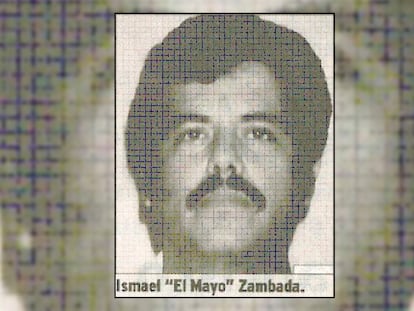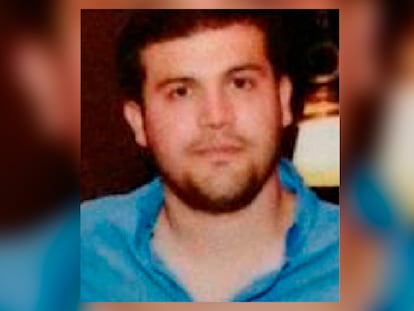Kidnapping theory gains traction in ‘El Mayo’ case: Ambush, betrayal and secret contacts with the US
Details over the arrests of the historic leader of the Sinaloa Cartel and one of the sons of ‘El Chapo’ Guzmán remain shrouded in mystery
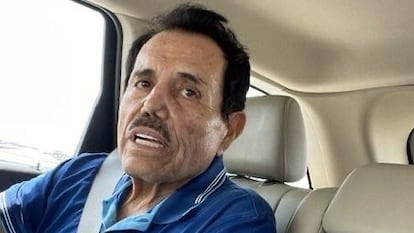
Joaquín Guzmán López, one of the sons of “El Chapo” Guzmán, kidnapped Ismael “El Mayo” Zambada in order to hand him over to U.S. authorities. This is the hypothesis that has gained traction following the fall of Zambada, the founder of the Sinaloa Cartel and one of the most feared and powerful criminals in the world. El Mayo, who had never set foot in a jail in more than five decades of his cartel career and had proven impossible to track down in his mountain refuges, was arrested last Thursday along with Guzmán López after landing in Santa Teresa (New Mexico), near the border city of El Paso, in a private plane with Guzmán López. In response to reports of an alleged pact to turn himself in to the authorities Frank Perez, the 76-year-old drug lord’s lawyer, claimed that his client had been “kidnapped” by the heir of his former partner. A report by The New York Times — citing three federal agents as well as former and current government officials — suggests that Zambada was tricked and ambushed by Guzmán López and handed over against his will on the other side of the U.S.-Mexico border.
According to this version of events, last week El Mayo left a hideout in the Durango highlands to meet Guzmán López, in what he thought would be a friendly encounter between the two in the metropolitan area of Culiacán, the Sinaloa Cartel’s stronghold and the capital of the northwest Mexican state. Perez testified last weekend that his client had been subdued by at least six men wearing military fatigues, raising questions about the involvement of Mexican or U.S. agents. The Mexican government has insisted that it was not involved in El Mayo’s capture and that it learned of the arrest through the U.S. Embassy. “They forced him onto the plane, Joaquín tied his legs to the seat and brought him to the United States against his will,” Perez said.
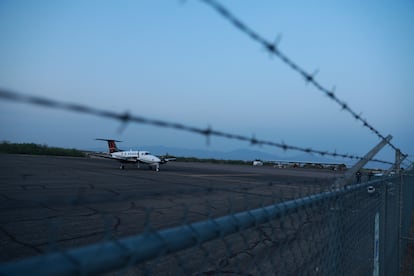
The NYT also quotes retired and serving officials who confirmed the United States has maintained secret contacts with cartel members for years and that Washington had no knowledge of what was going on in the hours leading up to the arrest. The administration of Andrés Manuel López Obrador on Monday made public an official report on the arrest requested from the Justice Department, which also confirmed that Guzmán López had discussed the possibility of turning himself in. Journalistic investigations indicate that Washington did not yet have a firm agreement with El Chapo’s son regarding his surrender, and the official report released by Mexican authorities acknowledges that U.S. security agencies did not know Zambada was on board the aircraft until two hours before the arrest was made, at around 4 p.m. on July 25.
The hypothesis of Guzmán López’s betrayal has set off alarm bells in Sinaloa over the possibility of an internal war between the two prominent cartel factions, one led by El Mayo and the other commanded by Los Chapitos, El Chapo’s sons. Ioan Grillo, one of the most experienced journalists covering the drug trade in Mexico, claims that Los Chapitos “are on red alert” for the possibility of “revenge,” according to one of his sources. Hours before the NYT’s publication, Grillo reported that Zambada had come from Culiacán to attend a medical appointment for cancer treatment and to meet with Guzmán López and Héctor Melesio Cuén, the former mayor of Culiacán, who was killed the same Thursday, hours after the arrest of the two drug lords.
According to a former member of El Mayo’s security team, Guzmán López’s hitmen ambushed four of Zambada’s bodyguards, tied up the drug lord, and flew him 20 miles to a ranch in Sinaloa, from where the plane that landed in New Mexico allegedly took off with the two cartel leaders as the only passengers. Other versions indicated that the aircraft took off from the neighboring state of Sonora, where the Attorney General’s Office opened an investigation to clarify the circumstances of the arrest. “It is not clear if they could have stopped at another airport in Sonora and then changed planes,” write Grillo and Juan Alberto Cedillo on the website CrashOut. “I still have an open mind about what happened,” said Grillo in an interview.
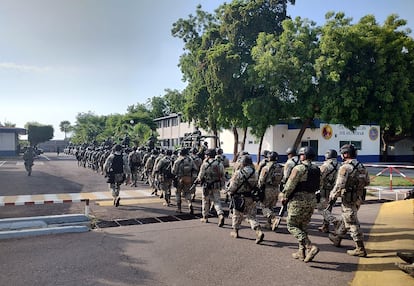
In Sinaloa, the scenario in which Héctor Melesio Cuén met with El Mayo is considered plausible. The politician, a former secretary of health in the state, won a seat as an Institutional Revolutionary Party (PRI) deputy for Sinaloa in the June elections. “The symbiosis between politics and organized crime is frequent. During and after campaigns, the acquiescence of these [criminal] groups is often sought. And in this particular case, with El Mayo’s people,” says a journalist from Culiacán who specializes in organized crime and asks for anonymity. “The times and places fit between the alleged meeting and where Cuén was killed,” he adds.
The Sinaloa Attorney General’s Office held a press conference on Monday with details of the investigation into the politician’s murder. An eyewitness to the attack said that the victim told him he was going to see “some lawyers” who, in the end, did not show up for the meeting, which was arranged at a country club in the north of Culiacán, an area close to where the alleged meeting between El Mayo and Guzmán López took place. The witness said that they were intercepted at a gas station by a couple of armed men and that Cuén struggled with them when they stole his truck.
The theft of the vehicle is the main line of investigation, although authorities have said they would not rule out any hypothesis. Prosecutors, however, did not mention links to organized crime as one of the motives for the attack. Members of Cuén’s inner circle are demanding that the death be investigated as a murder and a targeted attack, and not as a robbery. Local media are also considering the possibility that the murder was politically motivated. Investigations are still ongoing.
López Obrador’s Security Cabinet has opted not to jump to conclusions until it has more information on the arrests of Zambada and Guzmán López. The Mexican president also echoed the account of El Mayo’s lawyer and the blind spots in the details of El Mayo’s arrest. “We need to know everything, because the lawyers say that a son of Joaquín Guzmán was the one who arrested him,” he commented in his daily conference Monday. “They also say that there were people in military uniform. Military uniform from Mexico, from the United States? Where?” he asked. “The U.S. government itself is saying that they had been making agreements with Guzmán [López] for a long time.”
The lack of transparency surrounding the detention of El Mayo has once again undermined confidence in the bilateral relationship, especially in terms of security cooperation, as well as raising uncertainty about the participation of U.S. agents in the capture of the cartel leader on Mexican soil. Overall, the Mexican authorities have exercised caution in the days following Zambada’s arrest, amid an election campaign in the United States and with the fight against the cartels and immigration as one of the main banners of the most recalcitrant conservative sectors. Almost a week after El Mayo stepped off a plane and made a surprise appearance on the outskirts of El Paso, few questions have been answered.
Sign up for our weekly newsletter to get more English-language news coverage from EL PAÍS USA Edition
Tu suscripción se está usando en otro dispositivo
¿Quieres añadir otro usuario a tu suscripción?
Si continúas leyendo en este dispositivo, no se podrá leer en el otro.
FlechaTu suscripción se está usando en otro dispositivo y solo puedes acceder a EL PAÍS desde un dispositivo a la vez.
Si quieres compartir tu cuenta, cambia tu suscripción a la modalidad Premium, así podrás añadir otro usuario. Cada uno accederá con su propia cuenta de email, lo que os permitirá personalizar vuestra experiencia en EL PAÍS.
¿Tienes una suscripción de empresa? Accede aquí para contratar más cuentas.
En el caso de no saber quién está usando tu cuenta, te recomendamos cambiar tu contraseña aquí.
Si decides continuar compartiendo tu cuenta, este mensaje se mostrará en tu dispositivo y en el de la otra persona que está usando tu cuenta de forma indefinida, afectando a tu experiencia de lectura. Puedes consultar aquí los términos y condiciones de la suscripción digital.
More information
Archived In
Últimas noticias
There is as much life left to discover on planet Earth as that which is already known
Dozens presumed dead, around 100 injured in fire at Swiss Alps bar during New Year’s celebration
Is porn for women different from conventional porn? We spoke to those who make it
Cartagena de Indias is sinking: What can the city do to mitigate it?
Most viewed
- Reinhard Genzel, Nobel laureate in physics: ‘One-minute videos will never give you the truth’
- David King, chemist: ‘There are scientists studying how to cool the planet; nobody should stop these experiments from happening’
- Oona Chaplin: ‘I told James Cameron that I was living in a treehouse and starting a permaculture project with a friend’
- Sinaloa Cartel war is taking its toll on Los Chapitos
- The Interoceanic Train, the Mexican alternative to the Panama Canal

